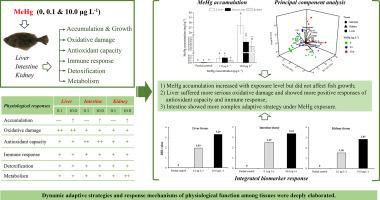探讨幼体比目鱼对水中甲基汞暴露的生理机制
IF 8
1区 环境科学与生态学
Q1 ENVIRONMENTAL SCIENCES
引用次数: 0
摘要
大量研究强调了甲基汞(MeHg)对鱼类的有害影响。然而,在海洋鱼类的早期生命阶段(ELSs)中,不同组织的生理反应机制仍然没有得到充分的了解。在此背景下,本研究利用牙鲆幼鱼(palichthys olivaceus)进行了为期15天的甲基汞暴露实验,暴露浓度分别为0、0.1和10.0 μg L−1。暴露后,我们评估了生长参数、甲基汞积累和反映一系列生理反应的生物标志物。结果显示,甲基汞在肝脏、肠道和肾脏中的积累具有明显的剂量依赖性和组织特异性趋势。具体来说,甲基汞的积累随着暴露浓度的增加而增加,其中肝脏的水平最高。值得注意的是,甲基汞暴露对鱼类生长没有显著影响。此外,MeHg在三种组织中均引起了大量的氧化损伤。相关生物标志物的活性升高表明,MeHg显著激活了与抗氧化能力、免疫反应、解毒和代谢相关的生理反应。主成分分析(PCA)证实了这些生理反应的剂量依赖性和组织特异性。结果表明,肝脏的氧化损伤和对抗氧化和免疫功能的毒性比其他组织更明显。生物标志物偏差指数(BDI)和综合生物标志物反应(IBR)的星形图显示了低和高MeHg暴露下不同生理反应所采用的动态适应策略,其中肠道表现出最复杂的反应。该研究为研究ELS期间海洋鱼类对甲基汞暴露的机制反应提供了有价值的见解。本文章由计算机程序翻译,如有差异,请以英文原文为准。

Investigating the physiological mechanisms of juvenile flounder in response to waterborne exposure of methylmercury
Numerous studies have highlighted the deleterious effects of methylmercury (MeHg) on fish. However, the mechanisms underlying the physiological responses across different tissues during the early life stages (ELSs) in marine fish remain insufficiently understood. In this context, the present study utilised juvenile flounder (Paralichthys olivaceus) to conduct a 15-day exposure experiment at concentrations of 0, 0.1, and 10.0 μg L−1 of MeHg. After exposure, we assessed growth parameters, MeHg accumulation, and biomarkers reflecting a range of physiological responses. The results revealed a significant dose-dependent and tissue-specific trend in MeHg accumulation in the liver, intestines, and kidneys. Specifically, MeHg accumulation increased with the exposure concentration, with the liver showing the highest levels. Notably, MeHg exposure did not significantly affect fish growth. Furthermore, MeHg induced substantial oxidative damage in all the three tissues. Physiological responses related to antioxidant capacity, immune response, detoxification, and metabolism were significantly activated in response to MeHg, as indicated by the elevated activity of relevant biomarkers. Principal component analyses (PCA) confirmed the dose-dependence and tissue specificity of these physiological responses. It revealed that oxidative damage and toxicity to antioxidant and immune functions in the liver were more pronounced than those in other tissues. Star plots of the biomarker deviation index (BDI) and integrated biomarker response (IBR) illustrated the dynamic adaptive strategies employed by different physiological responses under low and high MeHg exposure, with the intestine demonstrating the most complex response. This study provides valuable insights into the mechanistic responses of marine fish to MeHg exposure during the ELS.
求助全文
通过发布文献求助,成功后即可免费获取论文全文。
去求助
来源期刊

Science of the Total Environment
环境科学-环境科学
CiteScore
17.60
自引率
10.20%
发文量
8726
审稿时长
2.4 months
期刊介绍:
The Science of the Total Environment is an international journal dedicated to scientific research on the environment and its interaction with humanity. It covers a wide range of disciplines and seeks to publish innovative, hypothesis-driven, and impactful research that explores the entire environment, including the atmosphere, lithosphere, hydrosphere, biosphere, and anthroposphere.
The journal's updated Aims & Scope emphasizes the importance of interdisciplinary environmental research with broad impact. Priority is given to studies that advance fundamental understanding and explore the interconnectedness of multiple environmental spheres. Field studies are preferred, while laboratory experiments must demonstrate significant methodological advancements or mechanistic insights with direct relevance to the environment.
 求助内容:
求助内容: 应助结果提醒方式:
应助结果提醒方式:


